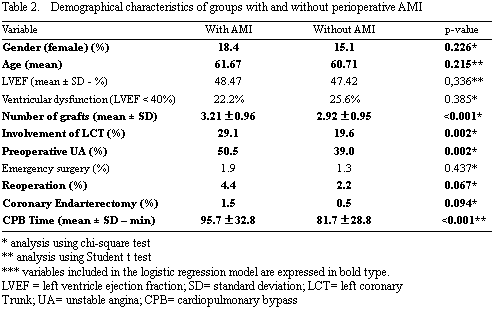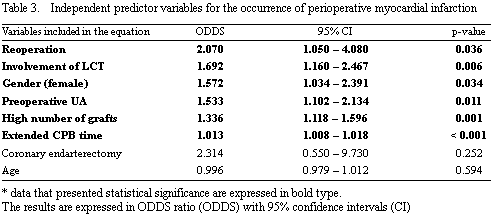INTRODUCTION
Thrombotic complications are considered the main causes of mortality in myocardial revascularization surgeries (MR). Among them, acute myocardial infarction (AMI) is stressed due to its high incidence, which varies from 5% to 15%, according to published data [1,2]. The consequences of perioperative AMI can vary from minor enzymatic increases without clinical relevance to states of low heart output or malignant tachyarrhythmias, followed by death or reduced survival over the long term [1]. This explains the amount of effort out in to attempt to avoid this complication.
Many North-American and European studies have demonstrated the main pre- and trans-operative factors that predict perioperative AMI; however, in Brazil, this data is unknown. Thus, this information is of great importance because, if this risk is identified and adequately controlled in the pre- and trans-operative periods, it will be possible to reduce this severe complication.
The purpose of this study is to determine which factors, among the main factors associated with perioperative AMI in on-pump MR as described in literature, are independent predictors for this outcome in a population of operated patients in a general hospital in Porto Alegre, Brazil.
METHOD
This is a retrospective cohort study, with prospective data collection for database organization. The studied population was patients submitted to MR in isolation in Hospital São Lucas of the Pontifícia Universidade Católica do Rio Grande do Sul (HSL-PUCRS) - Brazil. Out of the 2102 consecutive patients who performed heart surgery in HSL-PUCRS, between January 1998 and December 2002, 1580 patients performed MR and out of these, 1471 were submitted to MR in isolation, which made up the study group. The sample was a good representative of the cohort of patients submitted to MR, with an average age of 60.8 ± 10.1 years and 15.6% women. Diabetes mellitus was present in 27.5% of the cases; arterial hypertension in 67.9%; lesions of left coronary artery trunk (LCT) in 20.9%; and, on average, each patient received 2.96 ± 0.96 grafts. The average left ventricle ejection fraction (LVEF) in the preoperative period was 47.5 ± 12.1%; 2.5% of the patients had previously undergone MR; 1.4 % required emergency surgery; 0.6% performed coronary endarterectomy with the surgery and, finally, a high rate (40.6%) of patients suffered from unstable angina (UA) in the preoperative period (Table 1).
The criteria utilized to define AMI in the perioperative period of MR were those amply described in literature [1,2]: (1) new and persistent Q-waves on the electrocardiogram (ECG) within 48 hours of surgery associated with maximum serum CK-MB level > 30 U/L; (2) new and persistent blocks of the left branch seen on the ECG within 48 hours of surgery associated with maximum serum CK- MB level > 30 U/L; (3) maximum serum CK-MB level > 80 U/L, in isolation. The enzymatic sampling was performed at hours 0, 4, 8, 16, 24, 36 and 48 in the postoperative period; ECGs were performed at hours 0, 24 and 48 in the postoperative period.
Analysis of the database of the Postoperative Heart Surgery Unit of HSL-PUCRS was undertaken verifying the variables and the clinical outcomes of AMI. The following variables, that have been described in the literature as the main predisposing factors of perioperative AMI, that is, possible confounding factors, were controlled: age, gender, LVEF, lesions of the LCT, UA, coronary endarterectomy, emergency surgery, reoperation, number of grafts and cardiopulmonary bypass (CPB) time. The time of aortic clamping was not included in the analysis, as it is a variable with a similar pattern as CBP time (r= 0.82). The occurrence of three-vessel lesions was not evaluated as it is directly related to the number of grafts in the analytic model (r= 0.88).
The statistical analysis was achieved using the SPSS 11.0 program, with descriptive analysis of general data, the Pearson's correlation coefficient for the exclusion of variables with similar patterns in the analytic model, multivariable analysis using the chi-squared test for categorical variables and by the Student t-test for continuous variables and multivariable analysis by logistic regression of the variables that presented a value of p<0.2. The final results were presented as ODDs ratio (OR), with 95% confidence intervals (CI), which established a statistical significance of p< 0.05 for the multivariable analysis.
As this was a survey of hospital records of patients who were difficult to locate, either because they were already dead or their addresses unknown and, therefore, impossible to be located, consent forms were not signed by the participants. The heart surgery database in POUHS of the HSL-PUCRS has the approval of the Research Ethics Committee of this institution. This study was approved by the Research Ethics Committee of HSL-PUCRS and of the Institute of Cardiology/Fundação Universitária de Cardiologia (IC- FUC).
RESULTS
Out of 1471 patients included in the study, 206 (14%) patients presented perioperative AMI. In univariable analysis, some statistically significant differences were found between the groups with and without perioperative AMI. In Group 1 (with AMI), the average number of grafts was higher (3.21 ± 0.96 vs. 2.92 ± 0.95 - p-value < 0.001), as was the presence of LCT injury (29.1% vs. 19.6% - p-value = 0.002), preoperative UA (50.5% vs. 39.0% - p-value = 0.002) and the CPB time (95.7 ± 32.8 minutes vs. 81.7 ± 28.8 minutes - p-value < 0.001). There were no statistically significant differences between the groups with and without perioperative AMI in respect to gender, age, LVEF, emergency surgery, reoperations and associated coronary endarterectomy (Table 2).
With the aim of obtaining independent predictors of perioperative AMI, multivariable analysis was performed. The variables included in the equation were gender, age, presence of LCT injury, preoperative UA, associated coronary endarterectomy, reoperation, number of vascular grafts and CPB time. After logistic regression analysis, with adjustment for possible confounding factors, six variables were identified as independent predictors of perioperative AMI in MR: reoperation, LCT injury, gender (female), preoperative UA, number of grafts and CPB time.
COMMENTS
The sample, which is representative of a population of patients who were submitted to MR, provides data similar to those found in the MR database register of patients operated on during 2000 in the American Society of Thoracic Surgeons, thereby validating the selection of patients. In the American sample, the average age was 65 years, with 19% of the participants female, the incidence of LCT injury was 23%, reoperations 7%, and the average LVEF in the preoperative period 49% [3].
However, some methodological problems must be considered as potential limitations of the study. The reliability of the data can be harmed in studies performed retrospectively, however as the data was collected prospectively to set up the database, the chance of committing mistakes is minimized.
A combination of an increase in serum CK-MB and the presence of new Q-waves seen in the ECG examination were criteria utilized to define the diagnosis of perioperative AMI and are widely accepted in the medical world [1,2]. However, it is well known that the sensitivity and specificity of this combination of parameters is not the gold standard. Nevertheless, the practical logistic difficulty of transferring all patients from the intensive care unit in the first few postoperative days after heart surgery, when they are frequently in severe conditions, with pleural and mediastinal drains and sometimes with other apparatuses, such as catheters to monitor pulmonary arterial pressure and systemic arterial pressure, pacemakers and intra-aortic balloons, to a nuclear medicine laboratory to perform myocardial scintigraphy with pyrophosphate technetium, is unfeasible. Even though recently there have been some publications describing the use of troponin in MR [4-6], a consensus has not been reached yet that defines a cut-off point in the diagnosis of perioperative AMI.
Some authors already studied and described predicting factors of perioperative AMI. Bojar et al. [1] described LCT injury, three-vessel involvement, preoperative unstable angina, left ventricular dysfunction, left ventricular hypertrophy, associated coronary endarterectomy and extended aortic clamping time as the main predictors of perioperative AMI. Martins & Guaragna [7] added to these variables: advanced age, extended CPB time, incomplete revascularization, high number of vascular grafts, reoperation and thrombocytosis. Costa et al. [8] described the predisposing factors for the increases of CK-MB above upper reference limits in the postoperative period of on-pump MR, even considering the fact that the majority of these cases are secondary alterations after myocardial manipulation. The variables that were highlighted included: emergency surgery, preoperative coronary occlusion, and the first marginal artery as the target vessel, the use of short-acting nitrates, coronary angles greater than 90º in targeted segments and extended aortic clamping time. Eigel et al. [9] studied predicting factors of the first occurrence of perioperative AMI (19 events) or death (six events) in MR, with the total of 21 adverse results in the 540 patients evaluated. The variables gender (female), extended aortic clamping time and extended CPB time were demonstrated to be the predictors of the result in question. In our study, a higher number of patients was evaluated, compared with the two aforementioned studies and we found some variables in common with positive correlations, including gender (female), the extended CPB time, preoperative unstable angina and LCT injury. The number of grafts was evaluated in the studies of Costa et al. [8] and Eigel et al. [9] but proof of this being a predicting factor was not found; on the other hand 'reoperation' was considered to be an exclusion criterion in the aforementioned studies and therefore this factor was not analyzed.
CONCLUSION
In conclusion, in this study we found that the being a woman, LCT involvement, preoperative UA, reoperation, extended CPB time and a high number of grafts prove to be independent predictors of AMI in the perioperative period of MR, in this sample of patients operated on in a general hospital of Porto Alegre, Rio Grande do Sul, Brazil.
BIBLIOGRAPHIC REFERENCES
1. Bojar RM. Perioperative myocardial infarction. In: Bojar RM, editor. Manual of perioperative care in cardiac surgery. 3rd ed. Malden:Blackwell Science;1998. p.256-9.
2. Antman EM. Tratamento clínico do paciente submetido à cirurgia cardíaca. In: Braunwald E. Tratado de medicina cardiovascular. 5a ed. São Paulo:Roca;1999. p.1838-65.
3. The Society of Thoracic Surgeons. Data analysis of the Society of Thoracic Surgeons National Cardiac Surgery Database. Disponível em: http://www.sts.org [Acessado em 3/3/2004].
4. Leal JCT, Braile DM. Comportamento evolutivo imediato e valor prognóstico da dosagem sérica de troponina-I em pacientes submetidos a revascularização cirúrgica do miocárdica. [Dissertação de mestrado]. Campinas:Universidade Estadual de Campinas (UNICAMP);1999. 61p.
5. Savaris N, Polanczyk C, Clausell N. Cytokines and troponin-I in cardiac dysfunction after coronary artery grafting with cardiopulmonary bypass. Arq Bras Cardiol. 2001;77(2):114-9.
6. Nascente RB, Spiandorello FSA, Werutsky G, Azevedo E, Petracco JB, Bodanese LC. Serum concentrations of troponin I in the detection of acute myocardial infarction in coronary artery bypass grafting. Heart. 2004;90(suppl. III):A1-A8.
7. Martins R, Guaragna JCVC. Infarto agudo do miocárdio no pós-operatório de cirurgia cardíaca. In: Guaragna JCVC, editor. Pós-operatório em cirurgia cardíaca. Porto Alegre:Guanabara Koogan;2005. p.117-24.
8. Costa MA, Carere RG, Lichtenstein SV, Foley DP, de Valk V, Lindenboom W et al. Incidence, predictors, and significance of abnormal cardiac enzyme rise in patients treated with bypass surgery in the arterial revascularization therapies study (ARTS). Circulation. 2001;104(22):2689-93.
9. Eigel P, van Ingen G, Wagenpfeil S. Predictive value of perioperative cardiac troponin I for adverse outcome in coronary artery bypass surgery. Eur J Cardiothorac Surg. 2001;20(3):544-9.



 All scientific articles published at rbccv.org.br are licensed under a Creative Commons license
All scientific articles published at rbccv.org.br are licensed under a Creative Commons license